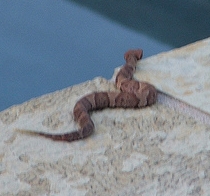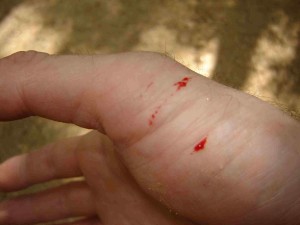There are many different types of snakes in North America. Most are harmless but the snakes that are not can really pack a punch, so before travelling in areas where venomous snakes can be found take time to familiarize yourself on how to identify the different types, where they can be found, and how snake’s appearance can change as they age. The wide variety of snakes and places they hide in makes it very difficult to plan for all circumstances so it is up to you to be prepared and know what to do if a bite or attack occurs.
Some guidelines to remember are:
•When walking in tall grass be sure to wear long pants and snake proof boots.
•Always look before reaching into tall grass, under a log, old tire or pile of rocks.
•A long walking stick is a good idea to beat grass or bushes before venturing into these areas when hiking, working, hunting or walking the dog.
•If you plan on venturing into remote places where medical help is not close by, bring a snake bite kit available from drug stores and outdoor outfitters.
•Check your sleeping bag, boots, blankets, clothes and boats if you are in an area with snakes before getting in or putting them on.
•Never attempt to catch or pick up a snake. They are wild animals and are unpredictable. Most bites each year come from people who tried to pick up a snake whether they knew it was venomous or not.
Contrary to popular belief a snake bite does not mean a death sentence. If you are bitten the most important things to do are:
1. Remain calm. Getting your heart pounding will spread the venom faster throughout your body. Look for one or two fang marks where the bite occurred. Often this will be on feet, legs, arms, and hands. A venomous bite should leave the victim feeling burning pain at the bite. There will be considerable swelling as well. There may not be much bleeding. Consult a first aid guide by a reputable source such as the Red Cross or St. John’s Ambulance if you are not close to a hospital.
2. Wash the bite wish soap and water if you will be a while before getting to a hospital. Snakes have dirty mouths and bacteria will likely infect the wound.
3. Keep the bite area immobile and lower than the heart.
4. Remove any rings, jewellery, watches, or clothing around the bite or on the limb that was bitten. The wound will swell so these items must be removed before the swelling starts.
5. Apply a 2’ wide lightly constricting band above and below the bite. The band should be just tight enough that one finger can be inserted behind it. Any tighter and blood flow could be cut off.
6. Get medical attention immediately. Antivenin must be given to reduce the effects of the venom and other treatments may be necessary.
7. Try to identify the snake. It will help doctors to know what type bit you.
Some points to remember if you are in the field:
1. Do not cut the wound. The venom will just spread making the situation worse.
2. Do not try to suck out the venom with your mouth. This doesn’t work very well. If you have a snakebite kit and will not delay getting to medical help then try to use it.
3. Do not apply a tourniquet. This will restrict blood flow and could cause the loss of the limb.
4. Do not apply ice or ice packs. The cold will make the injury worse and speed up deterioration of the affected tissue.
5. Don’t try to capture the snake alive. If possible kill it, but concentrate or getting away from it first.
6. Identify the snake before seeking medical attention. Doctors should be able to test you to determine what venom was injected, but since Rattlesnakes can inject hemo or neurotoxins depending on the particular type that bit it is important to be able to identify the snake that attacked. Fatalities can occur if the wrong type of antivenin is given to identification of the snake is very important.

Snakes are generally more afraid of you than you are of them. Locals are the best source of information of what they look like and where they can be found if you are visiting from out of town. Many snakes don’t exactly look like their pictures when you come across them unexpectedly.
Dogs and children can often be attacked by a snake as they run around outside so keep an eye on them if they are sniffing or playing around barns, logs, rocks, gardens or other obscured areas. In some cases snakes will creep into pools or backyard ponds so always take a look around before jumping in.
When it comes to venomous snakes an ounce of prevention really does equal a pound of cure.
Copyright 2019 Mike Wilson





